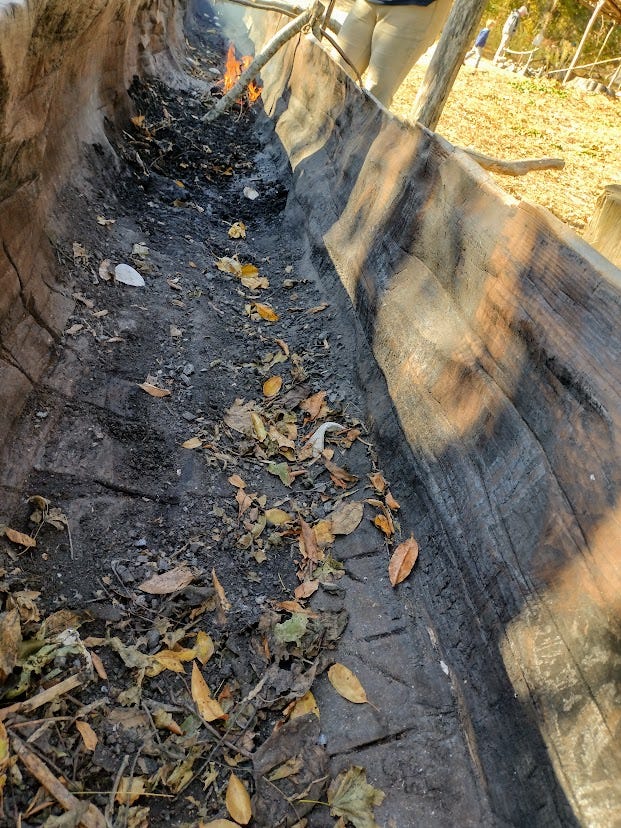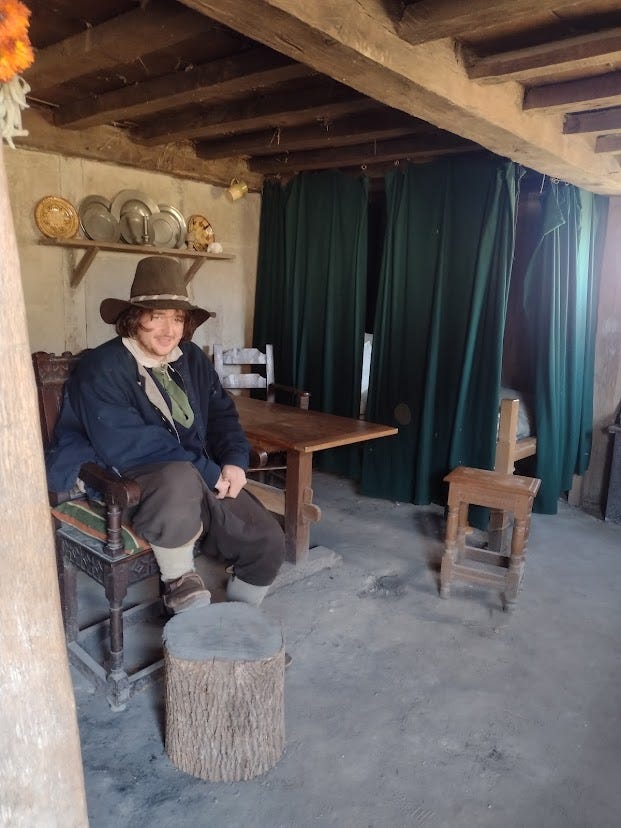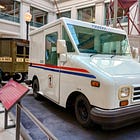A Ship They Call The Mayflower
ANNETTE ON THE ROAD They weren't the first. And they didn't sing the same American tune. At Plimoth Patuxet Museums, home of the Mayflower 2.0
New? Just having a look?
Non-Boring History is the work of Annette Laing, real historian (PhD), a Brit in America, taking you on an unpredictable, astonishing and often funny ride through academic history, museums, and more. Here’s what Non-Boring History is all about.
Singing an American Tune
This is American history. This is British history.
This is the history of the world.

When I was growing up in England, one of the few things I thought I knew about American history was that the first English settlers came on the Mayflower.
And since Simon and Garfunkel sang about that in American Tune, it had to be true! Alas, the “crap [Paul Simon] learned in high school” (a line from his song Kodachrome) was indeed pretty bad, I guess.
Judging from Google searches, many Americans (to this day) still think the Mayflower brought the first English settlers to America, and that the little ship was crammed full of people committed to religious freedom. Americans who know better are still often inclined to get all sentimental about the Mayflower Pilgrims, to wave aside what they gleaned from US history survey courses, including the prior claims to being “first” of Indigenous people (they win), the Spanish, and the colony of Virginia (settled thirteen years before the Mayflower).
In defiance of fact, many Americans insist on keeping the Mayflower afloat, front and center in American mythology.
I don’t care about this evidence of which you speak, they mutter. I have my own truth.
That’s nice.
But insisting that America's “real” founding was by the Mayflower's passengers is a stretch, and I'm being kind. This is one of many reasons why I have my work cut out for me here at Non-Boring House.
And so does Plimoth Patuxet Museums, which was known as Plimoth Plantation until 2020. It was renamed amid a national panic when museums saw a opportunity to stop pandering to ignorance, and get real. No, this isn't “wokeness gone mad.” It's about following historical evidence. Which is what historians do, and why we get cancelled from left and right, and not invited to parties.
In this museum’s defense, I do believe officials that they had planned this rebranding, because they have indeed redesigned the whole place over the past several years. And this early American historian thinks that what they have done (and are doing) is terrific.
I also want to mention in this post a subject close to my heart:
History is NOT just what’s in American school textbooks. Nor are textbooks holy scriptures. They are not, you notice, inscribed on gold tablets. They are a misguided summary of what it's believed (by whom? Good question) the average person needs to know about the past. That's not how history works.
History, proper academic history, by historians with proper PhDs in history, is not textbooks. It's historians’ ongoing conversation with each other, as we work with massive amounts of evidence to try, in good faith, to understand the past.
What we produce as scholarly work is not only hard for non-historians to read, but also sometimes a bit inconvenient for the public's most dearly-held beliefs. And because historians don’t just obediently repeat back to you what Mrs. Grabowski told you in third grade, we risk offending you, followed by you shouting at us while we try to hand you things to read and you flinging the books back in our faces. This is why we tend to hide from the public, burrowing down into our cozy archives.
I say “we” but, as someone who stepped back from an academic career to reach out to the public, I don't hide from you, not anymore. Obviously. Maybe.
You see, I still don't look forward to casual conversations and writing posts on subjects that the public thinks it knows well. Like the Mayflower.
Who Weren't They?
If you have questions about the Mayflower’s passengers, maybe they go like this:
Were the Mayflower people the same people who persecuted their neighbors as “witches” in 1692? (Quick answer: No.)
But they were Puritans, right? (Quick answer: No.)
And they all came to America to set up a colony for religious freedom, right? (Quick answer: No.)
And you're going to talk about the First Thanksgiving today, right? (Quick answer: No. But maybe one day.)
This is an Annette on the Road post, not one of the deep dives into books I take on this subject in Annette Tells Tales. But there is a fair bit I can say off the top of my early American historian head.
Meanwhile, let’s go back to when Hoosen, my long-suffering spouse, and I visited Plimoth Patuxet Museums on a crisp, clear Massachusetts weekday in early November, when we practically had the place to ourselves.
A Walk Through the Woods
Yes, Plimoth Patuxet Museums, and not just its name, really has changed since we last came here, when our grown son Hoosen, Jr. was but a lad.
The significance of the new murals on the entrance gate that shepherds us from the parking lot to the visitor center is easily missed as visitors charge past. But they’re worth the stop, because they were put here for a reason: Right away, Plimoth Patuxet Museums (note that “s”) is telling us that the story now told here is of two peoples, not just the Mayflower folk plus guests.

From the visitor center, we now start where we always should have: Not with the Mayflower, not with the English village of Plimoth, but in the woods.
Since our last visit, the museum has created a long entrance pathway through its grounds, and is now restoring the land with native species, to try to give some idea of how the landscape looked when the English arrived. In truth, the massive old-growth forests, trees so large that it took five men to stretch their arms around one, are long gone, but the Museum is doing all it can to remind us, nonetheless, that things were very different, once, a mere four hundred years ago. History is all about change.
This was not the virgin land that so many Americans have imagined existed when the Mayflower landed. Indigenous people lived here, burned the land, shaped it, BUT (and here's the thing) they did not exploit it all to extinction. That would not have been wise, would it?
So why did the English go a bit mad with their hatchets, chopping down everything in sight? No, not because they were horrible people. It happened because 17th century English settlers were astonished by the abundance of land and wood in America. Both of these were precious commodities of which they were running out at home.
As early as the Middle Ages, the King was using surprisingly modern methods to conserve his hunting forests, cutting back trees using coppicing and pollarding, so that they grew back with two or three trunks. You can still see the results near London at Hatfield Forest. Scotland, of course, was already a barren wasteland by then, its forests devastated (You thought it looked like that naturally? Oops.)
And then the English came to America, and found land and trees as far as the eye could see. To them, this was like winning the lottery.
Arriving in America, first in Virginia, English people went berserk, drunk on wood. Instead of breaking up stone or making bricks, let’s build houses from wood ! Let’s stay lovely and warm in the winter by burning wood with wild abandon! Let’s feed the cat on wood! Let's chop down trees, sell the wood, and grow drugs we can sell! Wood! Woot! Vast fortunes, here we come! 🎉🎉
They weren’t wrong.
The Curse of Abundance
Unfortunately, European incomers never quite recovered from the sheer abundance of America, of land and wood, and only when they were in danger of losing resources forever did anyone try to put the brakes on.
For that, thank Scotsman John Muir (1838-1914), who emigrated at age eleven, but never forgot his lovely East Lothian boyhood. He grew up in Wisconsin, an hour from where I’m sitting, and attended the University of Wisconsin, just a few miles from Non-Boring House.
But Muir—never losing his Scots accent— spent most of his life in California, where (with the support of his American wife Louisa) he led the way for preserving the breathtaking sights of the Yosemite Valley, and toward the creation of the first National Parks under President Theodore Roosevelt. Just in the nick of time, honestly. And not that we are yet, um, out of the woods.
Choose Your Own Adventure at NBH with a paying subscription: Visit John Muir’s unexpected house with me!
Visiting Patuxet First
Last time Hoosen and I were here, the recreated Wampanoag village of Patuxet was presented almost as an afterthought, a place where you might go if you weren’t too tired after seeing the recreated village of Plimoth, the Main Attraction. This sent an unfortunate message about the place of Indians in American history.
This time, museum signs encouraged us to think of the Wampanoag people as we walked onto the Museum grounds, through the woods, to begin to grasp that, for the Natives, every tree, every rock, every creature had meaning, value, and even a spirit. The forest was not a resource to be freely exploited, but a place to which they belonged, permanently, to this very day, one that, treated with respect, would give life forever.
At the end of the path, we found the recreated Patuxet. In one way, it’s more authentic than the recreated Plimoth, which is 2.5 miles from the original site. Patuxet is pretty much on a spot on the mouth of the Eel River where Wampanoag once lived.
Normally, the village is staffed by Mashpee Wampanoag people, because, yes, they are still here. They survived massive pandemic, caused by unfamiliar Old World diseases to which they had no resistance, that wiped out two thirds of them even before the Mayflower landed. They survived centuries of war, persecution, and being deprived of life, land, and opportunity.
This isn't a wokey rant. This is fact. The short bios of past leaders on the tribal website alone tell a story that reveals a lot about what it took for Mashpee Wampanoag to hold the community together amid hostility, exploitation, and non-Indian indifference over the centuries.
On the day of our visit, however, Mashpee Wampanoag staff were not present. A colleague explained that, when COVID began, the tribe had acted swiftly and decisively to protect their community, and especially their 98 year old Chief, from the horrors of COVID. Doing everything they could included retreating from their museum work. This was part of a story Hoosen and I spotted over and over on our travels that year, playing out in Indigenous communities across America, even including signs at Indian casinos with the stern notice that we must all protect the elders.
Honestly, it makes me tear up writing this. I dislike the popular romanticization of Indigenous people, all the mystical woo-woo stuff that’s imposed on them by outsiders: They are members of tribes and nations, they are Americans, they are people who consciously maintain traditional culture, from arts to community. They are modern people who run businesses, the largest of which benefit all members of a tribe. I encourage all of us to actually learn. I will say this, because it's true: Indian leadership in the 21st century on disease and environmental issues reflects collective wisdom born from hard history. It's a gift to us all, if we'll take it.
Where once was an Indian village, amid the skeletons of structures, a non-Indian but informed young interpreter was tending a small fire lit in a massive wooden canoe. It was forty feet plus, she told us, and intended for sea travel. The largest canoes, she said, could reach 100 feet long.
That’s about the same length as the Mayflower.
Fire is how the Wampanoag made canoes, slowly burning out tree trunks to create a means of travel that was much faster and more practical for goods and people than walking through the woods, for use on river and sea. You can read more about the canoe-building process here.
There's not much to the recreated Patuxet, but then there's not much to the recreated early Plimoth, either. That's a helpful reminder that whatever the landing of the Mayflower symbolized, it wasn't the arrival of a superior way of life. If anything, the English way of life represented the desperation that nurtures innovation. As my old professor John Phillips liked to point out, when the English had to prepare for war with the 16th century Spanish, whose fortunes from American gold and silver funded massive cannons, they invented cheap little cannons on wheels that could be quickly loaded on ships. Much better. Necessity, goes the old saying, is the mother of invention.
Plimoth Interiors
Here's an absolutely typical early Plimoth home. One room. Not even a loft, just basic shelter. Your Bible for entertainment, if you can read. Your kids sleeping on the floor. Except in winter, your life is lived mostly outdoors. Think of this as glamping, only year round, and it makes more sense. Is this really so far from vanlife? Or life in one of the shoebox new-style tenements called “luxury” apartments?

Face to Face With Mr. Thingummy from the 17th Century
Uniquely among living history museums, Plimoth’s first person character interpreters have always been left alone to speak to tourists in their best rendition of 17th century English. I well remember finding that a problem when I visited years earlier.
It was a long, brave experiment. Just last year, I was told, the Museum finally decided to add uniformed guides to help ease communications between first-person interpreters and public, something I’ve always thought they needed. Otherwise, you get all sorts of misunderstandings, and visitors who don't always grasp what they're being told in modern English, much less the Shakespearean kind.
Mind you, no matter how many staff are present, a lot of visitors to living history museums are grimly determined not to think or learn (cough, you should see them at Colonial Williamsburg, cough, where they come to worship). I really don’t know how you fix that.
This historian was eager for a close encounter of the 17th century kind. Unfortunately, on a quiet day as this was, costumed first-person interpreters were thin on the ground at Plimoth.
I was snapping a photo of one of the recreated houses when I was startled by a friendly greeting from the dark interior. I couldn't see anything through the gloom, but looking through my nifty phone camera, I could see the greeter:
Apart from Hoosen, there was no other tourist in sight. No uniformed staff member to explain things. We had Mr. 17th Century all to ourselves. Ooh! A chance for time travel!
Every first-person interpreter plays a real person in early Plymouth, based strictly on historical records. This guy was from Hampshire, he told me, and what a life it was that he now described in answer to my questions. He first left England, and his wife and kids, in pursuit of land in Virginia, where he spent five years as an indentured servant. Unusually, he was literate, which meant he could exchange mail with home. Sadly, it was through one of these letters that he learned of his first wife’s death. Having completely forgotten he was acting, I offered my sincere condolences.
Shortly after this letter arrived, he said, his servant indentures presumably having ended, he returned to England to care for his children. Since a widower wasn’t expected be a single parent, he soon remarried. He decided to join a ship bound for Virginia, and return with his family, determined to be a tobacco planter. Unfortunately, the ship got lost. Its name? The Mayflower.
Only about thirty of the Mayflower’s 100 plus passengers were the people we think of, on board to escape religious persecution. Like Mr. Thingummy, most on board were economic migrants, happy to remain Anglican. But it was the super-religious minority of about thirty who held the colony's charter, so they were in charge.
Who were these thirty plus, then? They were super-strict Calvinists. So strict, indeed, that unlike the Puritans, with whom they had much in common, they had no interest in “purifying” what they saw as a hopelessly corrupt Church of England, which they thought was well beyond saving.
So, while they still lived in England, they had done the unthinkable: They stopped going to church (a legal requirement, since church and state were united). They held their own services. Hassled, persecuted, and even executed, these “Separatists”, so called because they wanted complete separation from the Church of England, were desperate for relief.
They couldn't hang on, for, say, thirty years in case things changed. In fact, things did change, including the execution of the King in 1649, and the replacement of the monarchy with a Puritan republic that might have been more friendly to the Separatists’ religious views. Too late by then: They were in America. The Separatists had no crystal ball, so they weren't to know all that, were they? By the time King Charles I's head rolled, the ship, literally, had long ago sailed.
The first destination had not been America, mind. The future Mayflower Separatists had first emigrated simply by crossing the narrow English Channel to Holland. Unfortunately, because they didn't speak Dutch, they were stuck with the crappy, low-paid jobs typically reserved for immigrants. Watching as some of their party drifted off to join more interesting religions, and as their kids grew up Dutch, these English in exile began to think that immigrant life wasn’t for them. That’s why they came home and organized an expedition to …wait for it…
Virginia.
Honestly, the very idea of the Separatists landing in tobacco-mad early Virginia boggles the mind. Really, the rocky windswept coast of Massachusetts, while not where they intended to be, proved a better fit.
So how did our new 17th century friend (I think he said his name was Stephen but, being a historian, I’m really bad with names, and dates, so Mr. Thingummy he remains), how did our friend cope with living in a Separatist-run village in 1627?
He seemed reluctant to criticize, but he did hint that he wasn’t thrilled not to have proper Church of England services, or to be allowed to celebrate Christmas. These, however, were small sacrifices for a man who wasn’t a religious enthusiast. That was a dirty term in 17th century England, anyway. The modern version would be “God botherer”, someone just a bit too keen, too obsessive, too fanatical, which is very unEnglish of them.
Mr. Thingummy had got what he came for: Land. An unimaginable source of wealth in English eyes. His ultimate goal wasn’t to live in the kind of one-room, no-loft, colonial starter house in which I met him. But a fancy new house wasn’t his priority, either: His goal was making the most of the thin, rocky New England land he had been assigned, with the aim of remaining his own boss, and turning a profit.
In real life, by 1627, Mr. Thingummy probably didn’t even still live in the village, which began as a gated community with a fort boasting little cannons pointed in every direction, enclosed by a wooden palisade, or fence. By 1627, English settlers were spilling out of the village boundaries, and into more and more of the land on which Indigenous people relied.
But the impact of this on everyone was nothing compared with what was about to happen. Three years later, in 1630, thousands of Puritans began to arrive in Boston, forming the Massachusetts Bay colony, which officially absorbed tiny Plymouth in 1691.
So The Mayflower Wasn’t First, Then?
As you already know, Indians (but not the Wampanoag people as such, tell you about that some other time) were here first. The first English settlements in America were on Roanoke Island, off the coast of modern day North Carolina, in the South.
My adventure to Roanoke Island:
Like Roanoke, the first permanent English settlement (1607) was also in the South, in Jamestown, Virginia. So why does a tiny group of “Pilgrims” as William Bradford, their first governor, dubbed the first English settlers of the region we still call New England, loom so large in popular imagination?
It’s not too hard to understand. The first academic American historians, who shaped how people think about the past, even today, were not the diverse (in every way) band of historians that's emerged today. These pioneering professors were based in Ivy League universities, mostly in New England, and most were New Englanders. Their scholarly work was . . . How should I put this? . . . Ancestor worship.
Most importantly, Americans have never liked to think that their national roots are in profit-seeking and competitive Englishmen in the South, who made their money from drugs (tobacco) cultivated by, first, their exploited English brethren, and second, by enslaved Africans.
Next to these unsavory characters from the South, and even the witch-hanging Puritans of the much-larger Massachusetts Bay colony, the New England Separatists seem so much nicer.
Hmm. Well. Cough. This is a long story to which we’ll be returning one day. I’ll just mention for now that the Separatists’ commitment to religious freedom began and ended with themselves. Any other religions, including Anglicanism? Beyond the pale. Not to be tolerated. Because, after all, they were wrong. Enough said.
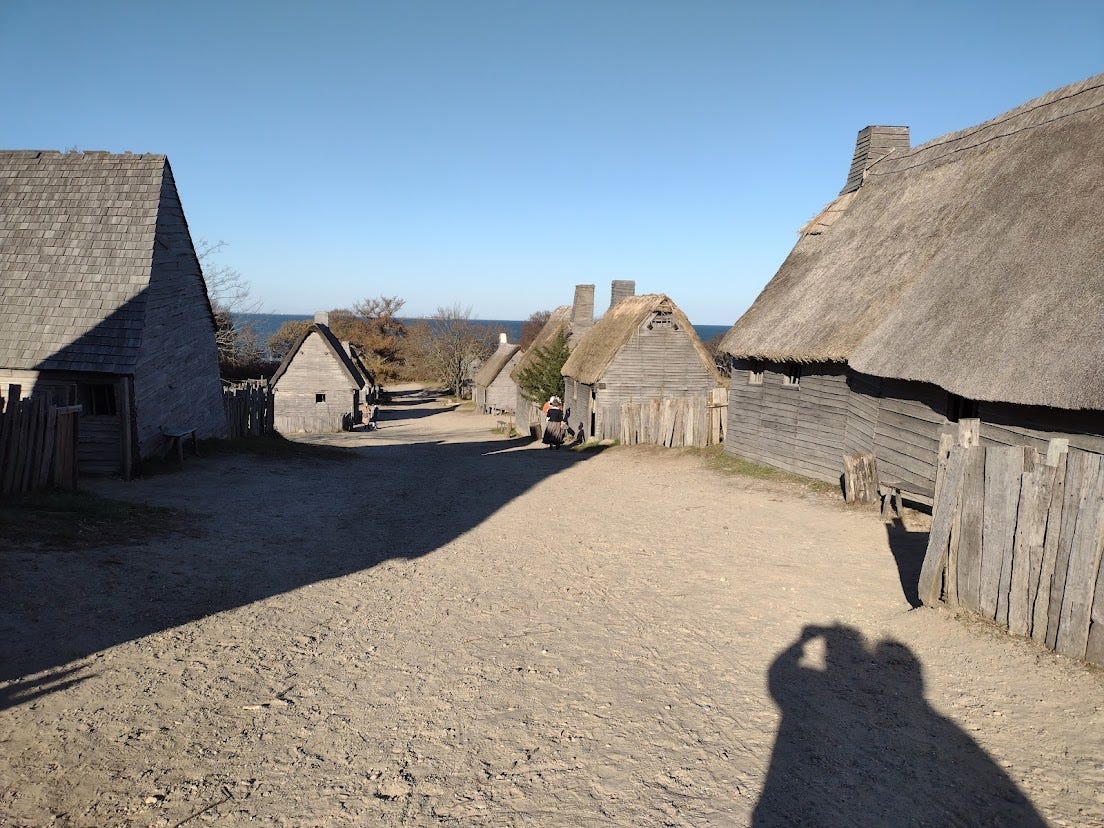
Confronting the Public With Mayflower Realities
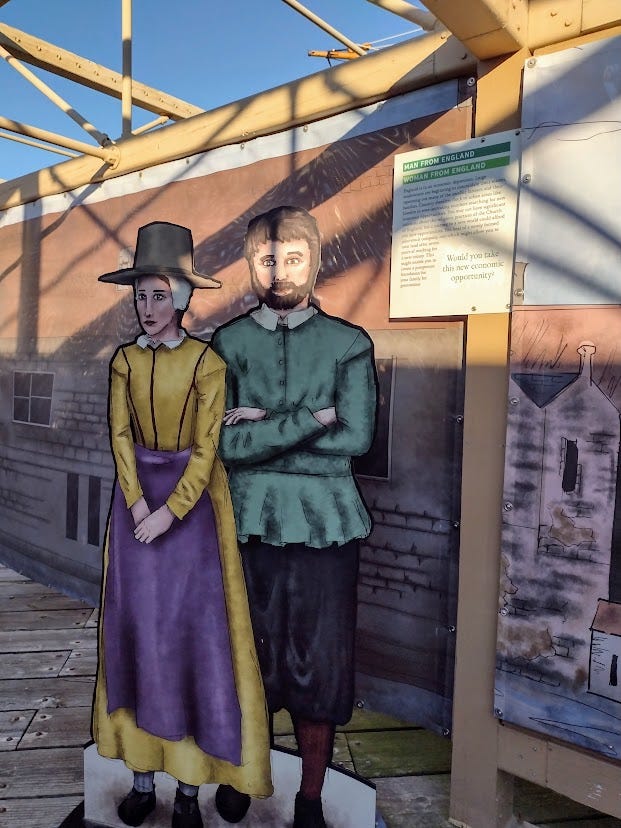
Hoosen and I didn’t bother revisiting Plymouth Rock, the large stone onto which the Mayflower people allegedly took their first step in America, and which used to be larger before people chiseled off bits of it for souvenirs. Been there, done that, total twaddle.

We did want to visit the Mayflower. However, we had to settle for the recreation, Mayflower II, the original being long gone. It wasn’t preserved, because it had no significance in the 1620s to make it worth preserving in glory, and the ship vanished from the records around 1624.
But Mayflower II gives us an idea. One hundred and two people, to be exact, crammed during storms into a below-decks space of 106 by 25 feet. There were kids, pregnant women, people who knew each other well, and people who were (and possibly intended to remain) strangers, crammed in with their loose luggage. Up to nine months of misery. No way to get off. Nowhere else to be.
Mr. and Mrs. Adamant, a depressingly young couple of tourists (maybe in their late thirties) joined us onboard, and they were not here to talk about facts. They were determined to think that the Mayflower people believed in religious freedom on principle. They were determined to keep thinking that their modern evangelical faith and that of the Separatists were the same True Christian beliefs (they weren’t, and if the Adamants celebrated Christmas, as they said they do, they would have been kicked out of Plimoth.)
The nice interpreter with the Massachusetts accent was trying hard to reach the Adamants. He pointed out that the Separatists wanted religious freedom only for themselves. That the inheritor of ever-evolving Puritan and Separatist beliefs was, most likely, the Congregational Church. But Mr. and Mrs. Adamant would have none of it. This happens a lot at historic sites. People come to worship, and to lecture, but they are determined, like the Adamants, not to learn. Everything they need to know, they have decided, they learned in third grade from Mrs. Grabowski.
On this occasion (as usual) this historian cravenly kept her mouth shut. I told them nothing. So I’m telling you, instead, as a reader who is inclined to listen and think. Thank you for that.
Ooh, and American readers, you now have a lot to chat about at the Thanksgiving table! Maybe you can hand out copies of this post, just to get the ball rolling. Bwahaha! Actually, that’s not the worst idea . . .
This post first appeared at Non-Boring History on November 21, 2021. For a steady supply of my brand new posts, become an annual, monthly, or patron-level subscriber!
NEW from Non-Boring History:
When I’m writing about American independence, or the lack of it in 1775, what’s 20th century British Prime Minister Harold Wilson doing in the picture? Well, smoking a pipe for one thing . . . :) Find out:
Who knew the US Postal Service has a history of technological innovation, and that it's shown off in a massive spectacular post office? Come visit it with me:
And Don’t American Tune This Out!
When you become an annual (best value) or monthly member, you get everything I post, access to five hundred posts at the NBH site, membership in the Nonnie Community, online talks and chats, the chance of in-person coffee ☕ with me, and much more!
Become a Nonnie today! Details here:






